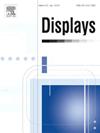Size-Encoding methods for depth information in augmented reality
IF 3.4
2区 工程技术
Q1 COMPUTER SCIENCE, HARDWARE & ARCHITECTURE
引用次数: 0
Abstract
In augmented reality (AR), bias in depth perception is a typical problem faced by users. Size encoding can provide useful depth cues to help AR users establish a connection between the augmented layer and the real world. This study aims to develop size encoding rules for augmented labelling of indoor spatial objects designed to represent depth layers on the basis of experimental research on human depth and size perception. In this study, we conducted two psychophysical experiments using the HoloLens 2. The depth perception stratification experiment provided a fitted relationship between subjective depth perception and physical depth, along with just noticeable difference (JND) values for depth perception. The size encoding experiment calculates the JND values for size differences. On the basis of the experimental results, we developed a list of depth information layers and size encoding layers for indoor spaces and proposed an augmented labelling size encoding method that effectively represents depth information.
The method can be applied to augmented information labelling in indoor spaces, and it has value for application in extended reality with overlay displays, which can be extended to virtual reality, augmented reality, and mixed reality devices.
增强现实中深度信息的尺寸编码方法
在增强现实(AR)中,深度感知偏差是用户面临的一个典型问题。尺寸编码可以提供有用的深度线索,帮助AR用户在增强层和现实世界之间建立联系。本研究的目的是在人类深度和尺寸感知实验研究的基础上,开发用于表示深度层的室内空间物体增强标记的尺寸编码规则。在这项研究中,我们使用HoloLens 2进行了两个心理物理实验。深度感知分层实验提供了主观深度感知与物理深度之间的拟合关系,以及深度感知的显著差异(JND)值。尺寸编码实验计算尺寸差异的JND值。在实验结果的基础上,建立了室内空间的深度信息层和尺寸编码层列表,并提出了一种有效表示深度信息的增强标记尺寸编码方法。该方法可应用于室内空间的增强信息标签,具有覆盖显示的扩展现实应用价值,可扩展到虚拟现实、增强现实和混合现实设备。
本文章由计算机程序翻译,如有差异,请以英文原文为准。
求助全文
约1分钟内获得全文
求助全文
来源期刊

Displays
工程技术-工程:电子与电气
CiteScore
4.60
自引率
25.60%
发文量
138
审稿时长
92 days
期刊介绍:
Displays is the international journal covering the research and development of display technology, its effective presentation and perception of information, and applications and systems including display-human interface.
Technical papers on practical developments in Displays technology provide an effective channel to promote greater understanding and cross-fertilization across the diverse disciplines of the Displays community. Original research papers solving ergonomics issues at the display-human interface advance effective presentation of information. Tutorial papers covering fundamentals intended for display technologies and human factor engineers new to the field will also occasionally featured.
 求助内容:
求助内容: 应助结果提醒方式:
应助结果提醒方式:


